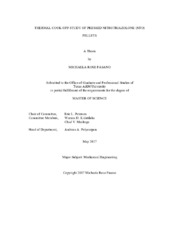| dc.description.abstract | As of today, no research has been performed to study the response of Compounded High Explosive Composite (CHEC) pellet arrays to fast or slow cook off. Cook-off tests are fairly standard tests for homogeneous-fill high explosives (HE’s), but, when using pressed pellet arrays as fill, the results of such cook-off tests are unknown. This research consisted of developing and designing an “indoor” cook-off test capable of testing pressed Nitrotriazolone (NTO) pellets to assess thermal stability characteristics and critical temperature.
The test method designed consists of the main testing vessel—the Petersen Group strand burner IV composed of 17-4 PH stainless steel with extreme pressure and temperature capabilities—a sample bolt holder used to hold the NTO pellet, a 400-W cartridge heater, two type K thermocouples, and an aluminized heat barrier. The cartridge heater was operated using a proportional-integral-derivative (PID) temperature controller. The data from the thermocouples used to monitor pellet and surrounding air temperatures were recorded using a USB-interfaced data logger capable of taking measurements at a rate of 1 sample per second.
A series of thermal cook-off tests was conducted revealing critical temperatures for the NTO pellets ranging between 175 and 203°C. For slow cook-off tests, the average critical temperature, TC, was determined to be 196±7ºC. Fast cook-off tests revealed an average TC of 189±1ºC. Due to these temperatures occurring over such a wide range and evidence of partially burned explosive residue material after each test, it is suggested that the pellets are undergoing premature decomposition, and thus a critical temperature for these NTO pellets cannot be determined to a high accuracy. As such, the thermal stability of NTO pellets in CHEC arrays remains to be verified. This thesis details the design and development of the “indoor” cook-off test as well as the thermal characteristics of the NTO pellets when exposed to extreme heating. | en |


